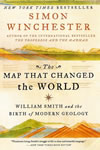The Map That Changed The World: William Smith and the Birth of Modern Geology
by Simon Winchester
William Smith (1769-1839), a self-educated man from Oxfordshire who was an enthusiastic collector of rocks and fossils, played a critical role in the development of modern geography. Smith was probably the first to fully grasp the underlying idea of stratigraphy — specifically that, since rock beds are seldom precisely parallel to the surface, you can learn about strata by moving across the surface as well as by digging beneath it. This idea led to his monumental map of 1815, the first large-scale geological map.
Smith was never a rich man and much of his career was plagued by debt and disappointment. But he travelled very widely and did not live meanly; his London house for many years was not far from Sir Joseph Banks, the great botanist, and Banks helped bail Smith out of his (ultimately-intolerable) financial morass.
Winchester is a lively and intelligent writer, and this is a fine and enjoyable volume. He pays, I think, too little attention to the intellectual climate of Smith’s time; Winchester often reminds us of the impending contest between the Church and Darwin, but doesn't mention the specter of civil war, Glorious Revolution, and French Terror that led Smith’s contemporaries to be so very, very reluctant to open windows into men’s souls and thus opened the door to science.
If ever a book asked to be lavishly illustrated, this one did, and Winchester’s vivid descriptions don’t entirely make up for the absent pictures. Smith built his ideas on visual evidence: the way stones looked, the way fossils in this stone looked a lot like fossils in that stone. Smith's geology was all about sands and soils and rocks, about driving around and seeing what was on (and in) the ground. It's all still there, and it would be nice to capture more of it in visual form.
